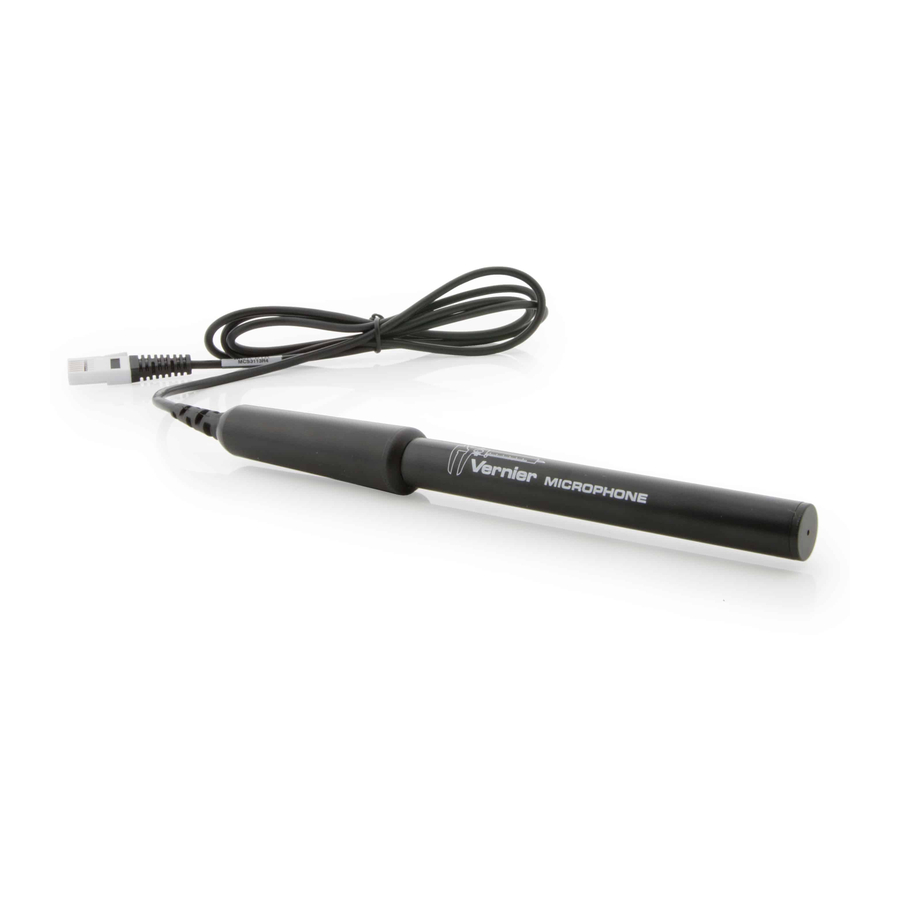
Table of Contents
Advertisement
Quick Links
Microphone
(Order Code MCA-BTA)
The Microphone can be used for a variety of
activities with sound waves.
Demonstrate how the wave pattern changes when frequency and amplitude are
changed.
Compare the waveforms from various musical instruments.
Have students capture the waveform of the sound of a tuning fork and model
the sine wave using a function.
Measure the speed of sound by using reflected sound waves in a tube.
Demonstrate beat patterns.
Determine the period and then the frequency of a sound by measuring the time
between peaks on the waveform.
Display the fast Fourier transform (FFT) of a sound.
Note: Vernier products are designed for educational use. Our products are not
designed nor are they recommended for any industrial, medical, or commercial
process such as life support, patient diagnosis, control of a manufacturing
process, or industrial testing of any kind.
What's Included
Vernier Microphone
Compatible Software and Interfaces
See
www.vernier.com/manuals/mca-bta
compatible with the Microphone.
Getting Started
1. Connect the sensor to the interface (LabQuest Mini, LabQuest 2, etc.).
2. Start the appropriate data-collection software (Logger Pro, Logger Lite,
LabQuest App) if not already running, and choose New from File menu.
The software will identify the sensor and load a default data-collection setup. You
are now ready to continue your experiment.
If you are collecting data using a Chromebook™, mobile device such as iPad
Android™ tablet, or a Vernier wireless sensor or interface, please see the following
link for up-to-date connection information:
www.vernier.com/start/mca-bta
Using the Product
Connect the sensor following the steps in the Getting Started section of this user
manual.
Some guidelines for collecting good waveforms:
By default, the microphone data-collection parameters are set such that it will
sample very quickly for a very brief time, effectively taking a "snapshot" of the
for a list of interfaces and software
sound waves present when data collection is started. With this in mind, start
the sound source you wish to investigate before starting data collection.
Make sure the sound level is in the correct range to produce good wave
patterns. If the sound is too loud, the wave pattern will be clipped off at the
top or bottom. Move the Microphone farther from the sound source or turn
down the volume of the sound.
Calibration
The Microphone is uncalibrated, which means that the vertical axis has arbitrary
units on waveform graphs. The voltage from the Microphone output is what is
graphed. For more information, see
Specifications
Frequency range
Power
Default calibration values
How the Sensor Works
The Microphone uses an electret microphone that has a frequency response
covering essentially the range of the human ear. An op-amp circuit then amplifies
the signal and outputs it to the British Telecom (BTA) connector. The output
signal is available on two pins in the BTA connector; for additional details see
www.vernier.com/til/3639
Troubleshooting
The best source of clean, sine-like waveforms is an inexpensive keyboard set to
the flute sound without vibrato.
For further troubleshooting tips, see
Repair Information
If you have followed the troubleshooting steps and are still having trouble with
your Microphone, contact Vernier Technical Support at support@vernier.com or
call 888-837-6437. Support specialists will work with you to determine if the unit
needs to be sent in for repair. At that time, a Return Merchandise Authorization
®
or
(RMA) number will be issued and instructions will be communicated on how to
return the unit for repair.
Warranty
Vernier warrants this product to be free from defects in materials and workmanship
for a period of five years from the date of shipment to the customer. This warranty
does not cover damage to the product caused by abuse or improper use. This
warranty covers educational institutions only.
www.vernier.com/til/656
Approximately 100 Hz to 15 kHz
1.45 mA @ 5 VDC
slope: 1
intercept: 0 (arbitrary units)
www.vernier.com/til/1436
2
Advertisement
Table of Contents

Subscribe to Our Youtube Channel
Summary of Contents for Vernier MCA-BTA
-
Page 1: Specifications
If you are collecting data using a Chromebook™, mobile device such as iPad ® (RMA) number will be issued and instructions will be communicated on how to Android™ tablet, or a Vernier wireless sensor or interface, please see the following return the unit for repair. link for up-to-date connection information: Warranty www.vernier.com/start/mca-bta... - Page 2 • www.vernier.com Rev. 3/17/16 Logger Pro, Logger Lite, Vernier LabQuest 2, LabQuest Mini, and other marks shown are our trademarks or registered trademarks in the United States. All other marks not owned by us that appear herein are the property of their respective owners, who may or may...
Need help?
Do you have a question about the MCA-BTA and is the answer not in the manual?
Questions and answers